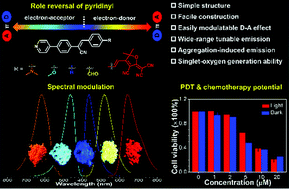Facile construction of AIE-active pyridinyl-diphenylacrylonitrile derivatives with optical properties finely modulated by D–A regulation†
Abstract
A series of simply-structured adducts of pyridine and diphenylacrylonitrile, i.e. PyDPACNs, featuring aggregation-induced emission (AIE) characteristics have been designed according to the principle of restriction of intramolecular motion (RIM), and facilely constructed via simple Knoevenagel condensation and Suzuki–Miyaura cross-coupling. The optical properties of these AIEgens could be finely modulated by the regulation of the electron-donating (D)–electron-accepting (A) effect, with the substituent on the terminal of the PyDPACN framework ranging from a strong D to strong A group. Interestingly, the role of the pyridinyl group could be flipped from an electron acceptor to an electron donor. Emission maxima of these PyDPACNs vary from 439 to 635 nm, covering nearly the whole visible light region. Amongst them, PyDPACNs with the strongest D (i.e. PyDPACN-N) or A group (i.e. PyDPACN-TCF) show the most significant intramolecular charge transfer (ICT) effect. PyDPACN-TCF possesses a high singlet-oxygen generation ability under white-light irradiation as well as moderate cytotoxicity in dark. The AIE mechanism, i.e. the RIM principle, was clarified through X-ray single crystal diffraction analysis. Density functional theory (DFT) calculations uncovered the electron-cloud distribution of PyDPACN derivatives in the ground and excited states, which not only reveals the role reversal of the pyridinyl moiety and the mutual conversion of D and A groups, but also provides an explanation for their distinct photophysical behaviours. The present work could provide both a new avenue for spectral modulation and effective molecular platforms for the development of advanced functional materials.

- This article is part of the themed collection: FOCUS: Recent progress on aggregation-induced emission


 Please wait while we load your content...
Please wait while we load your content...